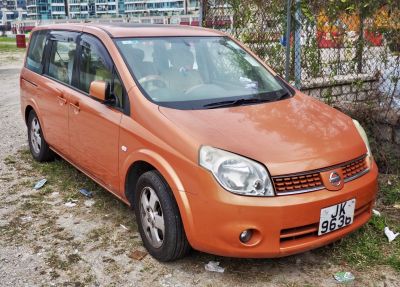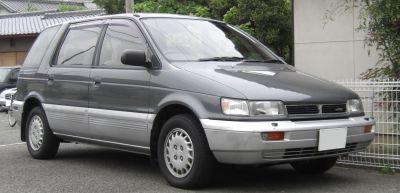 1991 Mitsubishi Space Wagon II Dimensions, Size & Specs
1991 Mitsubishi Space Wagon II Dimensions, Size & SpecsMeasurements of the 1991 Mitsubishi Space Wagon II, engineered for optimal performance and comfort
| Dimensions | |
|---|---|
| Length: | 4515 mm177.8 in14.8 ft |
| Width: | 1695 mm66.7 in5.6 ft |
| Height: | 1615-1630 mm63.6-64.2 in5.3-5.3 ft |
| Trunk Capacity: | 212 liter7.5 cu ft |
| Trunk Capacity (Max): | 1714 liter60.5 cu ft |
| Weight Specifications | |
| Curb Weight: | 1351-1436 kg2978-3166 lbs |
| Maximal permitted Weight: | 1980 kg4365 lbs |
| Tire Specifications | |
| Rims Size: |
|
| Tire Size: |
|
The Mitsubishi Space Wagon II, produced between 1991 and 1998, is a practical and versatile minivan designed to meet the needs of families and travelers alike. With an overall length of 4515 mm (177.6 inches), a width of 1695 mm (66.7 inches), and a height range of 1615 to 1630 mm (63.6 to 64.2 inches), this vehicle offers a balanced size for urban and suburban driving while providing ample interior space. Weighing between 1351 and 1436 kg (2,978 to 3,164 lbs) in curb weight, the minivan supports a maximum gross weight of up to 1980 kg (4,363 lbs), which attests to its capability for carrying passengers and cargo efficiently.
One of the most practical aspects of the Space Wagon II is its luggage capacity. When all seats are occupied, the available trunk space is 212 liters (7.5 cubic feet), suitable for everyday grocery runs or light luggage. However, folding down the rear seats dramatically expands the cargo area to an impressive 1714 liters (60.5 cubic feet), making it ideal for large loads or extended trips. This flexibility adds to the vehicle's reputation as a family-friendly minivan.
The vehicle rides on 14-inch rims, matched with tires sized 185/70 R14, providing a comfortable and stable ride while maintaining good maneuverability in tight spaces. The combination of its moderate dimensions and efficient layout ensures ease of parking and driving, alongside sufficient room inside for passengers.
Overall, the Mitsubishi Space Wagon II stands out as a reliable and moderately sized minivan from the 1990s, offering practical dimensions and functionality for various transportation needs. Its optimal combination of length, width, height, and weight makes it a competitive choice in the minivan segment of its era.
Discover the standout features that make the 1991 Mitsubishi Space Wagon II a leader in its class
Have a question? Please check our knowledgebase first.
The Mitsubishi Space Wagon II, produced from 1991 to 1998, measures 4515 mm (177.6 inches) in length. This size places it comfortably within the standard range for minivans of its era, which typically ranged between 4.4 to 4.8 meters (173 to 189 inches). Its length allows for a spacious interior while maintaining manageable exterior dimensions, making it suitable for family usage and urban driving conditions. Compared to some contemporaries, the Space Wagon II offers a balanced length that prioritizes interior room without making parking or maneuvering excessively difficult.
The width of the Mitsubishi Space Wagon II is 1695 mm (66.7 inches). This width supports a comfortable cabin environment for up to seven passengers, typical for a minivan designed during the 1990s. The car's moderately wide stance contributes to occupant comfort by offering adequate shoulder room without increasing road width excessively. Its width also helps the vehicle remain stable on the road. While narrower than some modern minivans, the Space Wagon II's dimensions were well-suited to family needs at the time, offering a harmonious balance between interior spaciousness and external practicality.
The Mitsubishi Space Wagon II's height ranges from 1615 mm to 1630 mm (approximately 63.6 to 64.2 inches). This height range provides good headroom for passengers in all three rows, contributing significantly to passenger comfort, especially for taller occupants. The slightly varying height is often due to different trim levels or suspension setups. The relatively tall design is typical for minivans, maximizing vertical space to optimize seating arrangement and cargo capacity. This attribute helps the Space Wagon II balance interior freedom of movement with an aerodynamic profile suitable for efficient driving.
The curb weight of the Mitsubishi Space Wagon II ranges between 1351 kg and 1436 kg (approximately 2978 to 3165 pounds). The maximum weight allowed is 1980 kg (around 4365 pounds), which accounts for passengers and cargo. The comparatively moderate weight aids in maintaining a reasonable balance between performance and fuel economy for its class. A lighter vehicle weight generally improves acceleration and reduces fuel consumption, especially essential in a family minivan. However, the Space Wagon II's design also ensures sufficient heft to maintain stability and safety on the road, contributing to a comfortable and reliable driving experience.
The Mitsubishi Space Wagon II offers a luggage capacity of 212 liters (about 7.5 cubic feet) when all rear seats are in use, which is somewhat modest but typical for a minivan designed for passenger comfort rather than cargo. When the rear seats are folded down, the luggage capacity expands dramatically to 1714 liters (approximately 60.5 cubic feet). This flexibility allows the vehicle to accommodate larger cargo loads, making it excellent for family trips or transporting bulky items. These figures highlight the Space Wagon II's practical design for mixed passenger and cargo needs, making it versatile for daily use as well as travel.
The Mitsubishi Space Wagon II comes standard with 14-inch rims paired with 185/70 R14 tires. These dimensions provide a good balance between ride comfort and handling stability. The relatively narrow tire width (185 mm) enhances fuel efficiency due to lower rolling resistance while maintaining adequate grip for safe driving. The 14-inch rim size was common in minivans of its generation, facilitating the use of high-profile tires that contribute to a softer ride by absorbing road bumps effectively. This setup ensures the minivan remains user-friendly, especially for urban driving and longer family trips.
Yes, the Mitsubishi Space Wagon II fits into a standard garage with typical door heights and widths. The vehicle's dimensions—4515 mm (177.6 inches) in length, 1695 mm (66.7 inches) in width, and up to 1630 mm (64.2 inches) in height—are compatible with most standard garage dimensions worldwide. Standard garage doors usually have a width of about 2400 to 2700 mm (94.5 to 106 inches) and a height of around 2000 to 2200 mm (78.7 to 86.6 inches), leaving sufficient clearance for the minivan. Owners should still consider minimal space for ease of entry and exit, but overall, the Space Wagon II’s size does not present unusual parking challenges.
The Mitsubishi Space Wagon II, produced from 1991 to 1998, is larger overall compared to its predecessor, which was produced earlier. The second generation measures 4515 mm (177.6 inches) in length, whereas the first generation was shorter, generally around 4350 mm to 4400 mm (171 to 173 inches). The width also increased slightly from earlier models, with the Space Wagon II at 1695 mm (66.7 inches) compared to narrower dimensions of the first generation. Height was adjusted upwards, enhancing interior space and comfort. These dimensional increases reflect Mitsubishi’s focus on improving passenger comfort, cargo capacity, and road presence while retaining a practical footprint for a family-friendly minivan.
Compared to other minivans of the early 1990s, such as the Toyota Previa or Honda Odyssey of the same era, the Mitsubishi Space Wagon II holds its own with balanced dimensions and practical interior features. With a length of 4515 mm (177.6 inches), it is slightly shorter than the Toyota Previa, which extends closer to 4800 mm (189 inches), but its width and height offer competitive passenger comfort. The Space Wagon II emphasizes efficient use of space with a flexible seating configuration and a large cargo volume when rear seats are folded, matching other minivans in versatility. While it may not offer the largest dimensions, its curb weight and tire setup contribute to manageable urban and highway drivability, positioning it as a practical choice in the segment.
The maximum permissible weight for the Mitsubishi Space Wagon II is 1980 kg (approximately 4365 pounds). Its curb weight ranges between 1351 and 1436 kg (around 2978 to 3165 pounds), meaning the vehicle can safely carry roughly 544 to 629 kg (1200 to 1387 pounds) of passengers and cargo combined. This capacity is typical for minivans and is suited for family transport, allowing a full complement of passengers along with luggage or other equipment. The robust weight rating ensures durability and safety, important for carrying heavier loads during travel or everyday tasks, while maintaining stable handling and braking performance.
Discover similar sized cars.

| Production: | 2004-2007 |
|---|---|
| Model Year: | 2005 |
| Length: | 4495 mm177.0 in |
| Width: | 1695 mm66.7 in |
| Height: | 1615 mm63.6 in |

| Production: | 1998-2003 |
|---|---|
| Model Year: | 1998 |
| Length: | 4515 mm177.8 in |
| Width: | 1695 mm66.7 in |
| Height: | 1580 mm62.2 in |

| Production: | 1991-1997 |
|---|---|
| Model Year: | 1991 |
| Length: | 4515 mm177.8 in |
| Width: | 1695 mm66.7 in |
| Height: | 1580-1595 mm62.2-62.8 in |

| Production: | 1999-2004 |
|---|---|
| Model Year: | 1999 |
| Length: | 4515 mm177.8 in |
| Width: | 1695 mm66.7 in |
| Height: | 1620 mm63.8 in |
